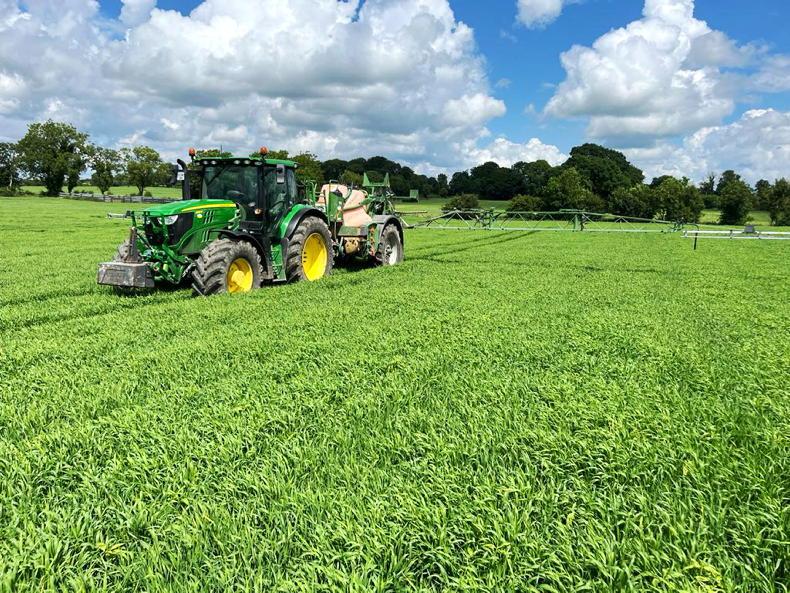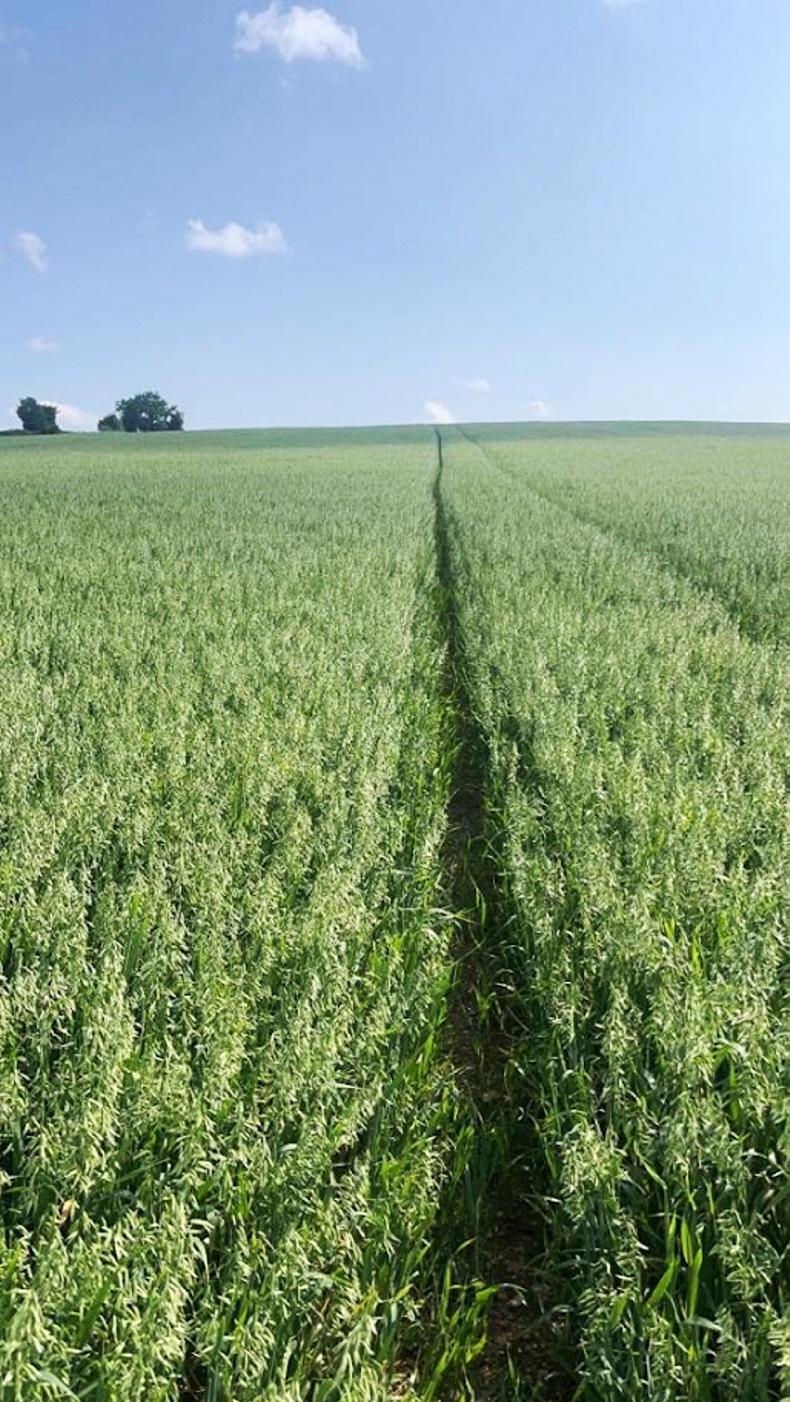Plenty of moisture over the past two weeks has been a welcome sight for Patrick.
He thinks that one more week without rain would have massively impacted the condition of his crops. Fortunately, the crops came through the dry period quite well, except for some late planted spring barley on shallow soils and hilly land, which thinned out and was burning up.
The spring barley drilled near the beginning of April is better, and while it won’t break any records, Patrick is happy with it considering the weather since planting.
The barley received its final spray on 13 June, which included Helix, Kavatur Plus, Lamast, and some N16, which will hopefully keep the leaves greener for longer. Patrick says there is very little disease pressure in the spring barley.
The gluten-free spring oats look quite good. They are relatively short, which Patrick is happy enough with as they should not lodge pre-harvest. He applied Elatus Era and Mastercrop K on 23 June as the ears were emerging.
He hopes the foliar potassium can help the oats to produce a good-quality grain.
The spring beans are flying it, with a lot of pods on every plant. They were not affected by the dry spell as they are in one of Patrick’s strongest fields with a more moisture-retentive soil, and which has had a lot of organic manures applied in recent years.
On 16 June, the beans were sprayed with a second fungicide, which included Signum, Basfoliar Aktiv, and a seaweed product. Patrick is very happy with this crop, and hopes it lives up to its potential at harvest time.
Patrick has recently planted his riparian buffers as part of ACRES. He has also decided to place much of his cereals into the Straw Incorporation Measure. This was due to the possibility of a late harvest and the fact that there will be a low volume of straw from these crops this year.
Combines are ready to roll in Westmeath as winter barley should be ready to harvest in a few days. Some of it started to lean over two weeks ago after the heavy rain, and this is giving Alex confidence that the crop will yield well.
The winter oilseed rape will also be ready to desiccate next week.
The winter oats are expected to be ripe about 10 days after the winter barley. They look pretty good, and there is no lodging. They only began to lose their green colour last week.
The gate was closed on the winter wheat over two weeks ago. A T3 spray of Decoy 250 EC (0.4l/ha), Comet 200 (0.5l/ha), Stavento (1.5l/ha) and Super K was applied. Alex says he is happy with 90% of the wheat, but that it is slightly dirtier than last year’s crop.
Alex finished the final fungicides on spring barley last week. Innox Pro (0.3l/ha), Serpent (0.6l/ha), and Stavento (1.5l/ha) were applied.
The late drilled barley looks surprisingly well and Alex is very optimistic about the crop. It managed to avoid the stresses of the dry period and has exploded since the rain with lots of tillers.

Alex spraying spring barley before it headed out.
The March planted crops probably still have the highest yield potential, but the late-drilled crops are not far behind. Alex says it is the crops planted in early April that are struggling the most, as the drought hit them as they were tillering.
The spring oilseed rape looks very good. There were some thistles in the crop so Dow Shield 100 was applied. Proline, boron and manganese have also been applied.
The maize is well over knee-high and has caught up on the late planting date.
Alex was concerned about weeds but the crop has grown quickly to shade them out. There are wild deer grazing on some very small areas of the maize, eating the whole plant, not just the leaves, down to the ground.
Over 50mm of rain since 17 June has quenched the thirst of all crops in Kildare, but Kevin says it may have arrived too late for the winter barley.
Speaking to Kevin on Monday, he was hoping to harvest some lighter fields this week if the weather allowed, with heavier fields about a week away from being ripe. The winter oilseed rape has been sprayed off in the past few days with Gallup XL (4l/ha), which is hoped to be ready to harvest in two or three weeks.

Markies potatoes being sprayed by O'Gormans. The slug pellet applicator can be seen on the sprayer boom.
The winter oats are also turning quite quickly and could be ripe at the same time as the oilseed rape. The T3 winter wheat fungicide was applied at mid-flowering. This consisted of Firefly (1.2l/ha) and Magnite (2l/ha). With the gate now closed on all winter cereals, the focus has turned to the potato crops.
The April-planted potatoes are in good condition, but the May-drilled crops are struggling a bit and have a lot of catching up to do. Kevin says it is difficult to see how they will produce good yields. With the current weather conditions, all potato crops are being sprayed for blight every seven to 10 days, with Revus, Ranman Top, and Zorvec being used alternatively. Cymoxanil is also being applied when spraying is delayed due to poor weather.
Slug pellets are also regularly being applied from the time that the crop begins to meet in the drills. They are applied with an Outcast applicator which is mounted on the sprayer and blows the pellets out to three 12m spinners mounted on the booms. This is working very well for O’Gormans, who are working off 30m tramlines. The slug pellets are applied at 4kg/ha for the first application, and are topped up whenever no pellets are visible on the ground.
Plenty of moisture over the past two weeks has been a welcome sight for Patrick.
He thinks that one more week without rain would have massively impacted the condition of his crops. Fortunately, the crops came through the dry period quite well, except for some late planted spring barley on shallow soils and hilly land, which thinned out and was burning up.
The spring barley drilled near the beginning of April is better, and while it won’t break any records, Patrick is happy with it considering the weather since planting.
The barley received its final spray on 13 June, which included Helix, Kavatur Plus, Lamast, and some N16, which will hopefully keep the leaves greener for longer. Patrick says there is very little disease pressure in the spring barley.
The gluten-free spring oats look quite good. They are relatively short, which Patrick is happy enough with as they should not lodge pre-harvest. He applied Elatus Era and Mastercrop K on 23 June as the ears were emerging.
He hopes the foliar potassium can help the oats to produce a good-quality grain.
The spring beans are flying it, with a lot of pods on every plant. They were not affected by the dry spell as they are in one of Patrick’s strongest fields with a more moisture-retentive soil, and which has had a lot of organic manures applied in recent years.
On 16 June, the beans were sprayed with a second fungicide, which included Signum, Basfoliar Aktiv, and a seaweed product. Patrick is very happy with this crop, and hopes it lives up to its potential at harvest time.
Patrick has recently planted his riparian buffers as part of ACRES. He has also decided to place much of his cereals into the Straw Incorporation Measure. This was due to the possibility of a late harvest and the fact that there will be a low volume of straw from these crops this year.
Combines are ready to roll in Westmeath as winter barley should be ready to harvest in a few days. Some of it started to lean over two weeks ago after the heavy rain, and this is giving Alex confidence that the crop will yield well.
The winter oilseed rape will also be ready to desiccate next week.
The winter oats are expected to be ripe about 10 days after the winter barley. They look pretty good, and there is no lodging. They only began to lose their green colour last week.
The gate was closed on the winter wheat over two weeks ago. A T3 spray of Decoy 250 EC (0.4l/ha), Comet 200 (0.5l/ha), Stavento (1.5l/ha) and Super K was applied. Alex says he is happy with 90% of the wheat, but that it is slightly dirtier than last year’s crop.
Alex finished the final fungicides on spring barley last week. Innox Pro (0.3l/ha), Serpent (0.6l/ha), and Stavento (1.5l/ha) were applied.
The late drilled barley looks surprisingly well and Alex is very optimistic about the crop. It managed to avoid the stresses of the dry period and has exploded since the rain with lots of tillers.

Alex spraying spring barley before it headed out.
The March planted crops probably still have the highest yield potential, but the late-drilled crops are not far behind. Alex says it is the crops planted in early April that are struggling the most, as the drought hit them as they were tillering.
The spring oilseed rape looks very good. There were some thistles in the crop so Dow Shield 100 was applied. Proline, boron and manganese have also been applied.
The maize is well over knee-high and has caught up on the late planting date.
Alex was concerned about weeds but the crop has grown quickly to shade them out. There are wild deer grazing on some very small areas of the maize, eating the whole plant, not just the leaves, down to the ground.
Over 50mm of rain since 17 June has quenched the thirst of all crops in Kildare, but Kevin says it may have arrived too late for the winter barley.
Speaking to Kevin on Monday, he was hoping to harvest some lighter fields this week if the weather allowed, with heavier fields about a week away from being ripe. The winter oilseed rape has been sprayed off in the past few days with Gallup XL (4l/ha), which is hoped to be ready to harvest in two or three weeks.

Markies potatoes being sprayed by O'Gormans. The slug pellet applicator can be seen on the sprayer boom.
The winter oats are also turning quite quickly and could be ripe at the same time as the oilseed rape. The T3 winter wheat fungicide was applied at mid-flowering. This consisted of Firefly (1.2l/ha) and Magnite (2l/ha). With the gate now closed on all winter cereals, the focus has turned to the potato crops.
The April-planted potatoes are in good condition, but the May-drilled crops are struggling a bit and have a lot of catching up to do. Kevin says it is difficult to see how they will produce good yields. With the current weather conditions, all potato crops are being sprayed for blight every seven to 10 days, with Revus, Ranman Top, and Zorvec being used alternatively. Cymoxanil is also being applied when spraying is delayed due to poor weather.
Slug pellets are also regularly being applied from the time that the crop begins to meet in the drills. They are applied with an Outcast applicator which is mounted on the sprayer and blows the pellets out to three 12m spinners mounted on the booms. This is working very well for O’Gormans, who are working off 30m tramlines. The slug pellets are applied at 4kg/ha for the first application, and are topped up whenever no pellets are visible on the ground.









 This is a subscriber-only article
This is a subscriber-only article










SHARING OPTIONS: